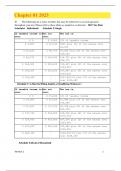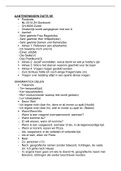Chapter 01 2023
Student name:__________
1) The following are a series of tables that may be referred to in several questions
throughout your test. Please refer to these tables as needed or as directed. 2021 Tax Rate
Schedules Individuals Schedule X-Single
M
If taxable income is But not The tax is:
over: over:
ED
$ 0 $ 9,950 10% of taxable income
$ 9,950 $ 40,525 $995 plus 12% of the excess over
$9,950
$ 40,525 $ 86,375 $4,664 plus 22% of the excess over
$40,525
C
$ 86,375 $ 164,925 $14,751 plus 24% of the excess over
$86,375
O
$ 164,925 $ 209,425 $33,603 plus 32% of the excess over
$164,925
$ 209,425 $ 523,600 $47,843 plus 35% of the excess over
N
$209,425
$ 523,600 — $157,804.25 plus 37% of the excess
over $523,600
N
Schedule Y-1-Married Filing Jointly or Qualifying Widow(er)
If taxable income is But not The tax is:
O
over: over:
$ 0 $ 19,900 10% of taxable income
IS
$ 19,900 $ 81,050 $1,990 plus 12% of the excess over
$19,900
$ 81,050 $ 172,750 $9,328 plus 22% of the excess over
SE
$81,050
$ 172,750 $ 329,850 $29,502 plus 24% of the excess over
$172,750
$ 329,850 $ 418,850 $67,206 plus 32% of the excess over
$329,850
U
$ 418,850 $ 628,300 $95,686 plus 35% of the excess over
$418,850
R
$ 628,300 — $168,993.50 plus 37% of the excess
over $628,300
Schedule Z-Head of Household
Version 1 1
, If taxable income is But not The tax is:
over: over:
$ 0 $ 14,200 10% of taxable income
$ 14,200 $ 54,200 $1,420 plus 12% of the excess over
$14,200
M
$ 54,200 $ 86,350 $6,220 plus 22% of the excess over
$54,200
ED
$ 86,350 $ 164,900 $13,293 plus 24% of the excess over
$86,350
$ 164,900 $ 209,400 $32,145 plus 32% of the excess over
$164,900
$ 209,400 $ 523,600 $46,385 plus 35% of the excess over
C
$209,400
$ 523,600 — $156,355 plus 37% of the excess
over $523,600
O
Schedule Y-2-Married Filing Separately
If taxable income is But not The tax is:
N
over: over:
$ 0 $ 9,950 10% of taxable income
N
$ 9,950 $ 40,525 $995 plus 12% of the excess over
$9,950
$ 40,525 $ 86,375 $4,664 plus 22% of the excess over
O
$40,525
$ 86,375 $ 164,925 $14,751 plus 24% of the excess over
IS
$86,375
$ 164,925 $ 209,425 $33,603 plus 32% of the excess over
$164,925
$ 209,425 $ 314,150 $47,843 plus 35% of the excess over
SE
$209,425
$ 314,150 — $84,496.75 plus 37% of the excess
over $314,150
U
R
Version 1 2
, 2) Oswald is beginning his first tax course and does not really have a solid understanding of
the role that taxes play in various decisions. Please describe for Oswald the various types of
M
decisions that taxes may influence.
ED
C
3) Determine if eachof the following is a tax and why or why not.
O
a. $2.50 toll paid on the Florida Turnpike
N
b. $300 ticket for reckless driving
c. 1 percent local surcharge on hotel rooms to fund public roadways
d. 2 percent city surcharge on wages earned in the city of Philadelphia
N
O
IS
SE
4) Although the primary purpose of a tax system is to raise revenue, Congress uses the
federal tax system for other purposes as well. Describe the other ways in which Congress uses
the federal tax system. Be specific.
U
R
Version 1 3
, 5) There are several different types of tax rates that taxpayers might use in different
contexts. Describe each tax rate and how a taxpayer might use it.
M
ED
C
6) Ricky and Lucy are debating several types of taxes. Their debate has focused on the
different types of tax rate structures and whether they are "fair." Please define each tax rate
O
structure, provide examples of each structure, and discuss how each structure may be viewed
with respect to vertical equity.
N
N
O
IS
7) Bart is contemplating starting his own business. His new business would operate as a sole
proprietorship and would require hiring several employees. Describe the employment-related
taxes that Bart should be aware of as he starts his new business as a self-employed business
SE
owner.
U
R
Version 1 4






